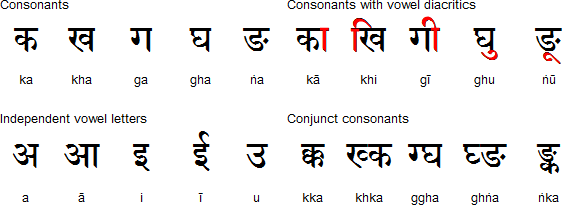A guide to some of the words that are used frequently on this site.
Abjad | Abugida | Accent / Diacritic | Alphabet | Consonant | Glyph | Logogram | Orthography | Pictogram | Syllabary | Vowel | Writing system
A script which represents consonants only. Vowel indication can be added, usually by means of diacritics. Most abjads are written from right to left. Also known as a consonant alphabet. Examples include Arabic, Hebrew and Syriac. Some abjads can also function as alphabets - e.g. the Arabic script when used to Kashmiri or Uyghur, and the Hebrew script when used to write Yiddish.
The image below shows the word 'language' in Arabic and Hebrew, both without vowel marks (unvocalised) and with vowel marks (vocalised).

More details: https://en.wikipedia.org/wiki/Abjad
[top]
An abugida is writing system consisting of basic characters which represent consonants followed by a particularly vowel. Diacritics are used to indicate other vowels or the absence of any vowel. They are also known as alphasyllabaries or syllabic alphabets. Examples include Devanagari, Bengali and Malayalam.

More details: https://en.wikipedia.org/wiki/Abugida
[top]
An accent or diacritic is dot, dash or other squiggle that appears above, below, within, or joined to a letter. For example: á, ê, ì, õ, ü, ç
More details: https://en.wikipedia.org/wiki/Diacritic
[top]
A script which includes symbols for consonants and vowels. Also known as a phonemic alphabet. Examples include Greek, Cyrillic and Armenian.

https://en.wikipedia.org/wiki/Alphabet
[top]
A speech sound that is articulated with complete or partial closure of the vocal tract. Examples include [p], [t] and [k].
More details: https://en.wikipedia.org/wiki/Consonant
[top]
An elemental symbol within an agreed set of symbols, intended to represent a readable character for the purposes of writing
More details: https://en.wikipedia.org/wiki/Glyph
[top]
A logogram or logograph is a written character that represents a word or phrase. In Classical Chinese, for example, each character represents a word. In Modern Chinese, however, some words are written with one character, while most are written with two or more characters. Logograms are also used in Egyptian hieroglyphs and the Mayan script.
More details: https://en.wikipedia.org/wiki/Logogram
[top]
An orthography is a set of conventions for writing a language. It includes norms of spelling, hyphenation, capitalization, word breaks, emphasis, and punctuation.
More details: https://en.wikipedia.org/wiki/Orthography
[top]
A pictogram, or pictograph, is a symbol that conveys its meaning through its resemblance to a physical object. Some writing systems, such as the Egyptian hieroglyphic script, use pictograms, and they are also used in the Chinese script, although they have became quite abstract over time and no longer resemble the objects they represent (see below).

More details: https://en.wikipedia.org/wiki/Pictogram
[top]
A syllabary is a phonetic writing system consisting of symbols representing syllables. A syllable is often made up of a consonant plus a vowel or a single vowel. Examples include Cherokee and the Japanese Hiragana and Katakana syllabaries.

More details: https://en.wikipedia.org/wiki/Syllabary
[top]
A speech sound pronounced without any stricture in the vocal tract. Examples include [a], [e] and [o].
More details: https://en.wikipedia.org/wiki/Vowel
[top]
A method of visually representing verbal communication using a set of conventional symbols which may represent the sounds of speech, and in some cases the meanings of words as well, in various ways.
More details: https://en.wikipedia.org/wiki/Writing_system
[top]
If you need to type in many different languages, the Q International Keyboard can help. It enables you to type almost any language that uses the Latin, Cyrillic or Greek alphabets, and is free.
If you like this site and find it useful, you can support it by making a donation via PayPal or Patreon, or by contributing in other ways. Omniglot is how I make my living.
Note: all links on this site to Amazon.com, Amazon.co.uk
and Amazon.fr
are affiliate links. This means I earn a commission if you click on any of them and buy something. So by clicking on these links you can help to support this site.